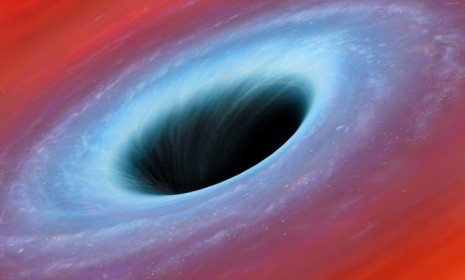The groundbreaking plan to photograph a black hole
Scientists want to build an enormous "virtual telescope" capable of taking a picture of a massive black hole 26,000 light years away

How do you take a picture of a black hole, a celestial object so dense it gobbles up light with its monstrous gravitational pull? An ambitious group of determined scientists will convene this week to discuss a project called the Event Horizon Telescope, with the goal of photographing a supermassive black hole deep in the heart of our Milky Way galaxy — the first such snapshot ever. "Even five years ago, such a proposal would not have seemed credible," says MIT's Sheperd Doeleman, the project's lead researcher, in a press release. "Now we have the technological means to take a stab at it." Here's the plan:
First off: What exactly is a black hole?
It's a "place in space where gravity pulls so much that even light cannot get out," says NASA. Black holes are often created by the death of a star, when an immense amount of matter is squeezed into an impossibly smaller space, drastically strengthening gravity's pull. Some black holes are as tiny as a single atom — others have a mass equivalent to millions of stars.
The Week
Escape your echo chamber. Get the facts behind the news, plus analysis from multiple perspectives.

Sign up for The Week's Free Newsletters
From our morning news briefing to a weekly Good News Newsletter, get the best of The Week delivered directly to your inbox.
From our morning news briefing to a weekly Good News Newsletter, get the best of The Week delivered directly to your inbox.
Why is it so hard to photograph a black hole?
Since no light can get out, black holes are invisible. Scientists can only hope to catch a glimpse of a black hole's "shadow," says Space.com. "As dust and gas swirls around the black hole before it is drawn inside, a kind of cosmic traffic jam ensues," notes Doeleman — like water draining in a bathtub. That "shadow" is known as a black hole's "event horizon" — and it can be photographed.
Are there other obstacles?
There sure are. Though the black hole that Doeleman and Co. want to photograph is estimated to be four million times bigger than our sun, it is "extremely compressed and far away," says Irene Klotz at Discovery News — about 26,000 light years from Earth. "To astronomers, it's like looking at a grapefruit on the moon."
A free daily email with the biggest news stories of the day – and the best features from TheWeek.com
So... how do you take a photo of it?
Scientists would need an "enormous" telescope with a mirror as large as a planet, says Travis Korte at The Huffington Post. Obviously, constructing a single telescope that big and powerful isn't possible. So the Event Horizon Telescope would combine the networked viewing power of some 50 telescopes from all over the globe, from Hawaii to the South Pole. "In essence," says Doeleman, "we are making a virtual telescope with a mirror that is as big as the Earth."
Sources: Discovery News, Huffington Post, NASA, Space.com
-
 Political cartoons for December 6
Political cartoons for December 6Cartoons Saturday’s political cartoons include a pardon for Hernandez, word of the year, and more
-
 Pakistan: Trump’s ‘favourite field marshal’ takes charge
Pakistan: Trump’s ‘favourite field marshal’ takes chargeIn the Spotlight Asim Munir’s control over all three branches of Pakistan’s military gives him ‘sweeping powers’ – and almost unlimited freedom to use them
-
 Codeword: December 6, 2025
Codeword: December 6, 2025The daily codeword puzzle from The Week